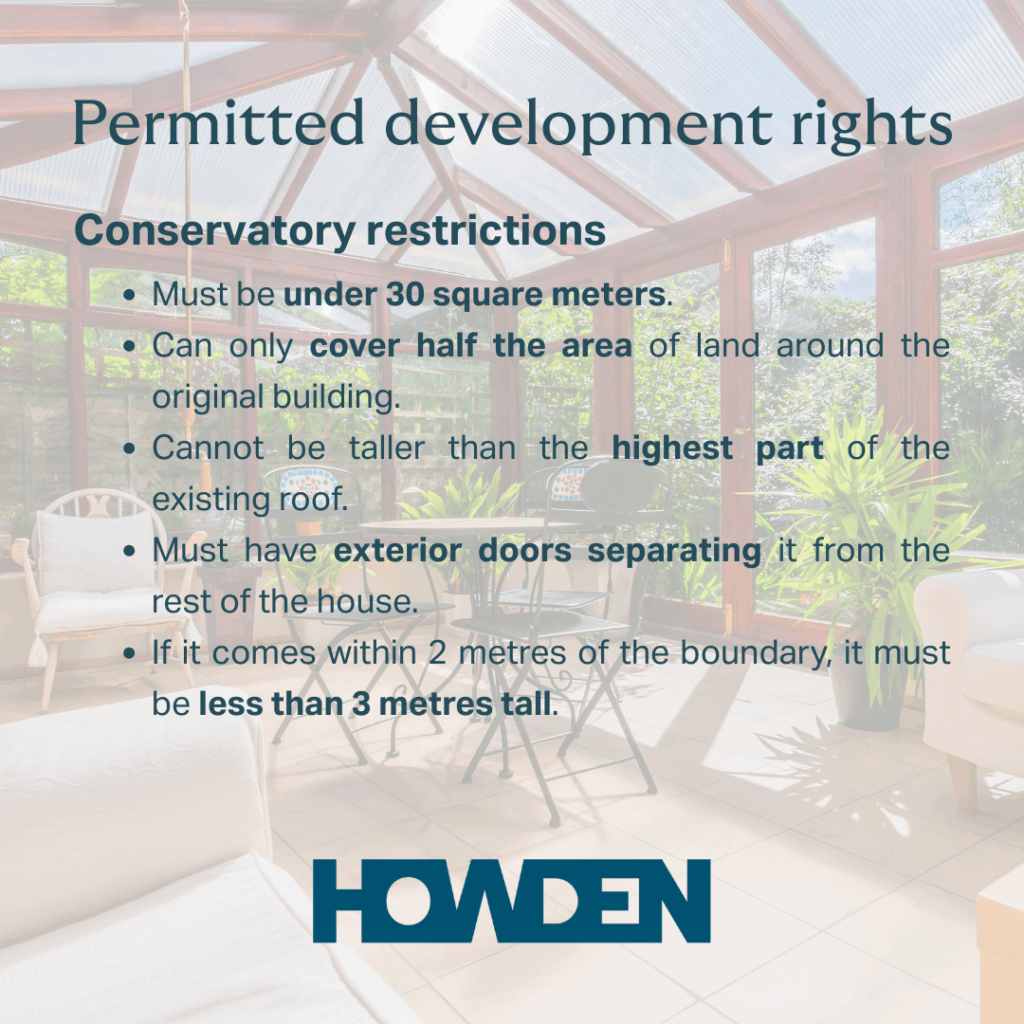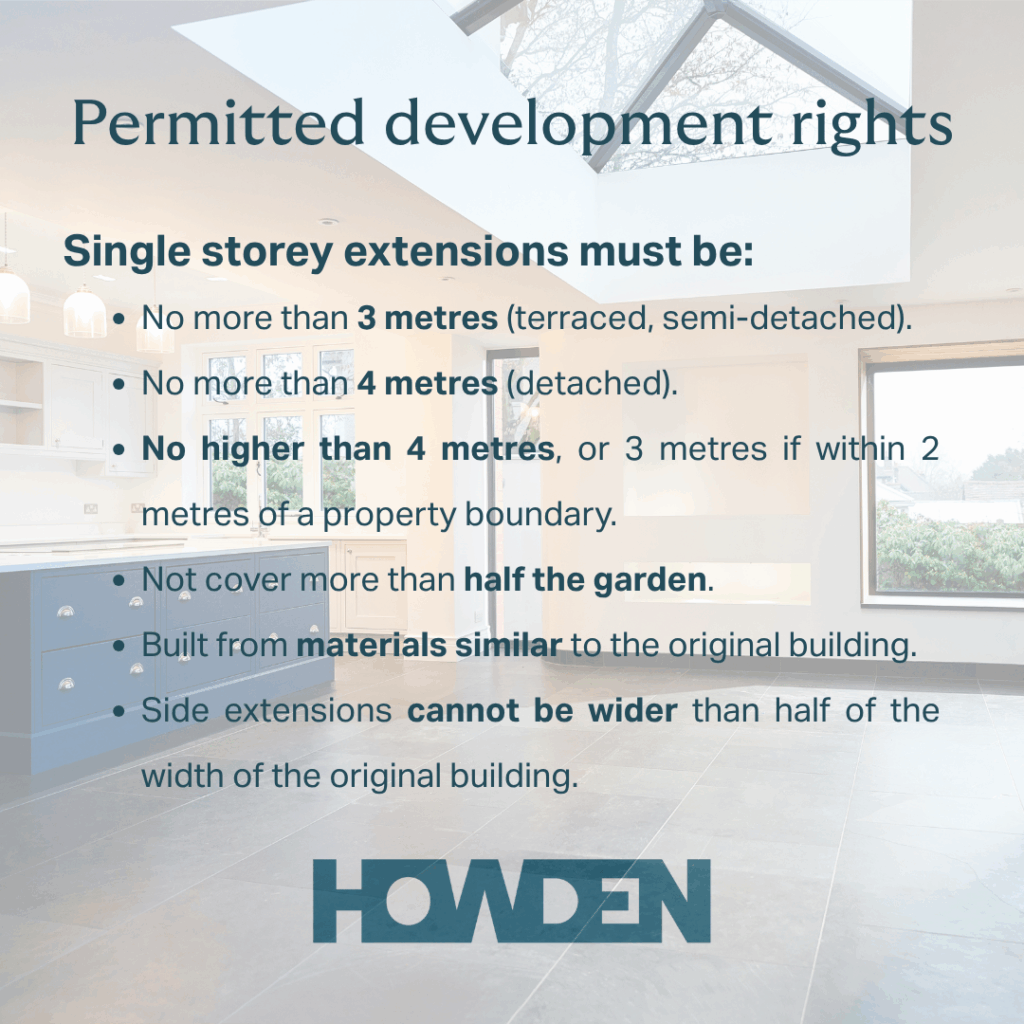Thinking of upgrading your home, but dreading the red tape? Good news: many improvements can be made under “permitted development rights” meaning you can skip the planning permission process.
However, it’s crucial to understand the rules to avoid costly mistakes. Here’s your guide to savvy home upgrades that keep you on the right side of the law.
1. Extensions
Yes, you can build an extension without planning permission, provided it sticks to certain criteria. It depends on the type of property you have, and whether it falls under certain dimensions.
Adding another storey
If you have a bungalow, you can add one storey under permitted development rights. If your home already has two storeys, you can add up to two more, so long as:

Loft conversions
Transforming your loft into a function space is typically allowed without planning permission. You can:

2. Garage conversions
Converting an existing garage into living space typically doesn’t require planning permission, as long as:
- The work is internal and does not involve enlarging the building.
- The garage is not detached; converting a detached garage may require permission.
Building regulations approval is necessary to ensure the new space is safe and habitable. And if your garage is detached and you want to convert it into an annexe or bedroom, you will need full planning permission.
If your garage was built after your home, then you should check with your local authority that it hasn’t already used your home’s permitted development allocation.
3. Solar panels
You can install solar panels is without planning permission, provided:
- They do not protrude more than 200mm beyond the roof plane.
- They are not installed above the highest part of the roof.
Again, rules may be different for listed buildings or conservation areas.
4. Internal renovations
Most internal changes, such as installing a new kitchen or bathroom, do not require planning permission. You can replace windows, doors or even rooflights, and knock down walls.
There will be exceptions though – you may need buildings regulations approval on structural and electrical works, and if your alterations affect listed buildings.
5. Conservatories
You can add conservatories under permitted development rights. Much like other extensions, buildings regulations approval is needed and there are guidelines. Your new conservatory must be:

Surprising things that do require planning permission
While many projects fall under permitted development, some seemingly minor changes can catch homeowners off guard.
1. Greenhouses, sheds and garden buildings
You may think that because these aren’t attached to the house, you don’t need planning permission. But that’s only true for greenhouses, sheds or garden buildings of a certain size.
If the structure covers more than 50% of the land around the house, is in front of the property, or exceeds certain height restrictions, then you need planning permission.
2. Pruning trees
It may seem like a mundane task, but many trees are protected by preservation orders. So before you take your secateurs out into the garden and start chopping, make sure you don’t need consent from the local authority to prune them.
And if you want to fell a protected tree, you’ll need planning permission. Read more about gardening and little-known laws you could be breaking!
3. New driveways
If you’re considering changing your driveway, or maybe paving over lawn to build one, then you may need planning permission. It all depends on the size, material you use, surface water drainage and how much it could affect your neighbours.
For example, gravel or permeable concrete paving allows rainwater to drain into the ground, and may not need planning permission. Tarmac or concrete are impermeable, so you’d need planning consent. If you’re paving more than 5 square metres then you’ll need planning permission too.
4. Decking
Again, this all depends on the size and height of your design. Any timber decking that’s 30cm above ground level could create a situation where you’re overlooking a neighbouring property. And for that, you’ll need planning permission.
Similarly, if your proposed decking will cover upwards of 50% of your garden area, then you’ll need permission.
5. Fences and walls
Any fence or wall over 2 metres high requires permission, or 1 metre if adjacent to a highway, requires permission. If you share a boundary, consult your neighbours beforehand to avoid any disputes.
If things go wrong
Let’s say you make a change to your home or garden, without any required planning permission. Your local authority can demand that you submit a ‘retrospective planning application’ for the work that’s been done.
Doing things this way is risky. If the application is refused, you could earn an enforcement notice that requires you to return everything to how it was before. And you’ll have to pay for it all. So it really isn’t worth it!
Don’t forget insurance!
While planning permission might not always be necessary, insurance is another matter entirely. Certain renovations can alter the value of your property, increase risk (especially during building works), or even leave you temporarily underinsured if you don’t update your policy.
At Howden, we make it simple. From reviewing your current cover to arranging specific insurance for ongoing works (like renovation or unoccupied home insurance), we’re on hand to make sure you’re properly protected. Pop into your local Howden Insurance branch or get in touch online for tailored advice from real people who understand the value of your home—inside and out.
Sources: Zoopla, GOV.UK, Property Wire, Checkatrade
You could also read:
- Car insurance prices drop 23% for young drivers!
- The most iconic on-screen number plates
- Good debt vs bad debt when buying a home
- Five hidden costs that could derail your holiday!
- 20mph zones – how effective are they?
This is a marketing blog by Howden Insurance.



